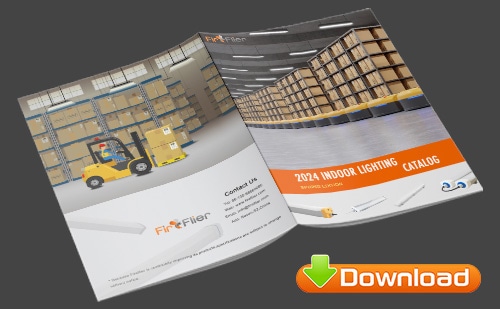What is high bay lighting, and what applications benefit from it?
Whenever a large indoor space needs to be illuminated, high bay lighting is usually appropriate. Consider spaces like manufacturing facilities, gymnasiums, warehouses, large department stores, factories, and more; these facilities are typically vast and cover a lot of vertical as well as horizontal space. This requires powerful lighting to provide the appropriate foot-candle levels to adequately illuminate. High bay lighting fixtures typically hang from the ceiling via hooks, chains or pendants, or they may be fixed to the ceiling directly.
Various industries and facilities require high bay lighting. Some of the most common are:
- Warehouses
- Industrial facilities
- Manufacturing facilities
- School and university gymnasiums
- Municipal facilities like community centers or recreation centers
- Commercial applications like department stores
Why LED high bay lights instead of Metal Halide, Fluorescent, or other conventional high bay lights?
Historically, various types of lighting technology were (and still are) used in warehouse and industrial settings when high bay lights were required. Some of the most common include metal halide (MH), high pressure sodium (HPS), and fluorescent. While each of these bulbs have their merits, industrial LED lighting outperforms its conventional counterparts in important ways. Let’s take a look at some of the various considerations when deciding whether an LED retrofit is appropriate for your warehouse or industrial space.
- Industrial LED lighting vs Metal Halide high bay lights: If you’ve ever been to a ballgame, chances are that the lights illuminating the field are metal halide. MH lamps are common in sporting and warehouse/industrial uses (as well as any setting where large, high spaces need to be illuminated). Benefits of MH lights include decent color rendering and comparatively adequate foot-candle levels (as opposed to other types of conventional bulbs). Some of their major drawbacks are that they take a long time to warm up (sometimes 15-30 minutes), they are expensive to maintain, their failure characteristics include flickering on and off, and much of the energy they produce is wasted as heat.
- LED high bay lighting vs High Pressure Sodium (HPS) lights: HPS lights are often used in warehouse, industrial, business, and recreational facilities where high bay lighting is appropriate. Their benefits include cheap selling price, the high energy efficiency (low operating costs), and the relatively long lifespan. HPS lighting technology retains these advantages over most conventional bulbs, but they lose on all three counts to LED high bay lighting. The downsides of HPS bulbs include the worst color rendering on the market and a warm up period.
- Industrial LED lighting vs Fluorescent lighting: Though somewhat less common, fluorescent lighting is sometimes utilized in warehouse or industrial applications (primarily T12, T8, and T5 lights). The benefits of fluorescent lights include cheaper initial costs and relatively high efficiency (especially when compared to other conventional bulbs). Downsides include the presence of toxic mercury (which requires certain waste disposal procedures), decreased lifetime if switched on and off, and requiring ballast to stabilize the light.
What are three major benefits of using LED lighting technology for all applications?
It’s no secret that LED lighting technology has surpassed the capabilities of conventional lighting in important ways. In addition to the considerations discussed above, there are three general benefits of LED lighting that apply to all lighting applications.
- Decreased maintenance requirements. As discussed above, LED lightshave a lifespan that is four to forty times longer than many conventional bulbs. This means fewer replacements for bulbs that wear out. LED lighting technology also generates light differently than typical fuel and filament lighting, by using a diode instead. This means that there are fewer moving pieces to break, and consequently, fewer repairs or replacements. Maintenance is an especially important consideration when it comes to industrial lighting or warehouse lighting. By definition, high bay lights have higher mounting heights, which means that changing a bulb requires some specialized equipment or creativity. Scaffolding, catwalks, and hydraulic lifts are generally used to swap or replace bulbs, and each of these can result in additional maintenance or equipment costs. Again, the lifespan of industrial LED lighting means that fixtures need to be changed much less often, which means savings for your bottom line.
- Improved lighting quality. Industrial LED lighting and high bay lights will typically score better in a head-to-head comparison against most other bulbs when it comes to Color Rendering Index (CRI), Correlated Color Temperature (CCT), and Foot Candles. CRI is a measurement of a light’s ability to reveal the actual color of objects as compared to an ideal light source (natural light). In non-technical terms, CCT generally describes the “glow” given off by a bulb – is it warm (reddish), or cold (bluish white)? Foot candles compare the amount of light coming from a source and the amount of light hitting the desired surface; they’re basically a measure of efficiency. On all three fronts, LED lights perform very well.
- Increased energy efficiency. Not only do LED lights generate light differently, they also distribute light differently than conventional lighting solutions, which results in less energy required to provide the same output. How does that work? First, many conventional lights waste a lot of the energy they produce by emitting it as heat (this is especially the case with metal halide lighting). Second, most conventional lights are omnidirectional, which means that they output light in 360 degrees. So, a lot of light is wasted pointing at a ceiling, or being diluted because it has to be redirected through the use of fixtures. Industrial LED lighting for applications that require high bay lights eliminates these two problems of wasted energy (through heat loss and omnidirectional emission).
Do you have more questions about high bay lighting?
As always, please feel free to reach out and ask us any questions directly – we would be honored to help you on your way to improved energy efficient lighting solutions.


